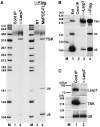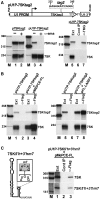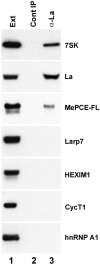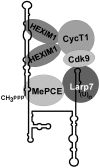RNA elements directing in vivo assembly of the 7SK/MePCE/Larp7 transcriptional regulatory snRNP
- PMID: 23471002
- PMCID: PMC3632141
- DOI: 10.1093/nar/gkt159
RNA elements directing in vivo assembly of the 7SK/MePCE/Larp7 transcriptional regulatory snRNP
Abstract
Through controlling the nuclear level of active positive transcription elongation factor b (P-TEFb), the 7SK small nuclear RNA (snRNA) functions as a key regulator of RNA polymerase II transcription. Together with hexamethylene bisacetamide-inducible proteins 1/2 (HEXIM1/2), the 7SK snRNA sequesters P-TEFb into transcriptionally inactive ribonucleoprotein (RNP). In response to transcriptional stimulation, the 7SK/HEXIM/P-TEFb RNP releases P-TEFb to promote polymerase II-mediated messenger RNA synthesis. Besides transiently associating with HEXIM1/2 and P-TEFb, the 7SK snRNA stably interacts with the La-related protein 7 (Larp7) and the methylphosphate capping enzyme (MePCE). In this study, we used in vivo RNA-protein interaction assays to determine the sequence and structural elements of human 7SK snRNA directing assembly of the 7SK/MePCE/Larp7 core snRNP. MePCE interacts with the short 5'-terminal G1-U4/U106-G111 helix-tail motif and Larp7 binds to the 3'-terminal hairpin and the following U-rich tail of 7SK. The overall RNA structure and some particular nucleotides provide the information for specific binding of MePCE and Larp7. We also demonstrate that binding of Larp7 to 7SK is a prerequisite for in vivo recruitment of P-TEFb, indicating that besides providing stability for 7SK, Larp7 directly participates in P-TEFb regulation. Our results provide further explanation for the frequently observed link between Larp7 mutations and cancer development.
Figures









Similar articles
-
Stabilize and connect: the role of LARP7 in nuclear non-coding RNA metabolism.RNA Biol. 2021 Feb;18(2):290-303. doi: 10.1080/15476286.2020.1767952. Epub 2020 Jun 3. RNA Biol. 2021. PMID: 32401147 Free PMC article. Review.
-
A capping-independent function of MePCE in stabilizing 7SK snRNA and facilitating the assembly of 7SK snRNP.Nucleic Acids Res. 2010 Jan;38(2):360-9. doi: 10.1093/nar/gkp977. Epub 2009 Nov 11. Nucleic Acids Res. 2010. PMID: 19906723 Free PMC article.
-
LARP7 is a stable component of the 7SK snRNP while P-TEFb, HEXIM1 and hnRNP A1 are reversibly associated.Nucleic Acids Res. 2008 Apr;36(7):2219-29. doi: 10.1093/nar/gkn061. Epub 2008 Feb 16. Nucleic Acids Res. 2008. PMID: 18281698 Free PMC article.
-
Release of positive transcription elongation factor b (P-TEFb) from 7SK small nuclear ribonucleoprotein (snRNP) activates hexamethylene bisacetamide-inducible protein (HEXIM1) transcription.J Biol Chem. 2014 Apr 4;289(14):9918-25. doi: 10.1074/jbc.M113.539015. Epub 2014 Feb 10. J Biol Chem. 2014. PMID: 24515107 Free PMC article.
-
The 7SK snRNP complex: a critical regulator in carcinogenesis.Biochimie. 2025 May 12:S0300-9084(25)00084-7. doi: 10.1016/j.biochi.2025.05.003. Online ahead of print. Biochimie. 2025. PMID: 40368082 Review.
Cited by
-
Cracking the control of RNA polymerase II elongation by 7SK snRNP and P-TEFb.Nucleic Acids Res. 2016 Sep 19;44(16):7527-39. doi: 10.1093/nar/gkw585. Epub 2016 Jul 1. Nucleic Acids Res. 2016. PMID: 27369380 Free PMC article. Review.
-
Functional interplay between PPM1G and the transcription elongation machinery.RNA Dis. 2016;3(1):e1215. Epub 2016 Mar 14. RNA Dis. 2016. PMID: 27088130 Free PMC article.
-
Stabilize and connect: the role of LARP7 in nuclear non-coding RNA metabolism.RNA Biol. 2021 Feb;18(2):290-303. doi: 10.1080/15476286.2020.1767952. Epub 2020 Jun 3. RNA Biol. 2021. PMID: 32401147 Free PMC article. Review.
-
CDK9 keeps RNA polymerase II on track.Cell Mol Life Sci. 2021 Jul;78(14):5543-5567. doi: 10.1007/s00018-021-03878-8. Epub 2021 Jun 19. Cell Mol Life Sci. 2021. PMID: 34146121 Free PMC article. Review.
-
Interaction of the Ankyrin H Core Effector of Legionella with the Host LARP7 Component of the 7SK snRNP Complex.mBio. 2019 Aug 27;10(4):e01942-19. doi: 10.1128/mBio.01942-19. mBio. 2019. PMID: 31455655 Free PMC article.
References
-
- Peterlin BM, Price DH. Controlling the elongation phase of transcription with P-TEFb. Mol. Cell. 2006;23:297–305. - PubMed
-
- Yamaguchi Y, Takagi T, Wada T, Yano K, Furuya A, Sugimoto S, Hasegawa J, Handa H. NELF, a multisubunit complex containing RD, cooperates with DSIF to repress RNA polymerase II elongation. Cell. 1999;97:41–51. - PubMed
Publication types
MeSH terms
Substances
LinkOut - more resources
Full Text Sources
Other Literature Sources

